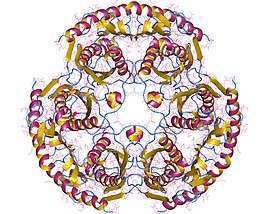tRNA nucleotidyltransferase
In enzymology, a tRNA nucleotidyltransferase (EC 2.7.7.56) is an enzyme that catalyzes the chemical reaction
- tRNAn+1 + phosphate tRNAn + a nucleoside diphosphate
| tRNA nucleotidyltransferase | |||||||||
|---|---|---|---|---|---|---|---|---|---|
 RNase PH hexamer, Pseudomonas aeruginosa | |||||||||
| Identifiers | |||||||||
| EC number | 2.7.7.56 | ||||||||
| CAS number | 116412-36-3 | ||||||||
| Databases | |||||||||
| IntEnz | IntEnz view | ||||||||
| BRENDA | BRENDA entry | ||||||||
| ExPASy | NiceZyme view | ||||||||
| KEGG | KEGG entry | ||||||||
| MetaCyc | metabolic pathway | ||||||||
| PRIAM | profile | ||||||||
| PDB structures | RCSB PDB PDBe PDBsum | ||||||||
| Gene Ontology | AmiGO / QuickGO | ||||||||
| |||||||||
where tRNA-N is a product of transcription, and tRNA Nucleotidyltransferase catalyzes this cytidine-cytidine-adenosine (CCA) addition to form the tRNA-NCCA product.
Function
Protein synthesis takes place in cytosolic ribosomes, mitochondria (mitoribosomes), and in plants, the plastids (chloroplast ribosomes). Each of these compartments requires a complete set of functional tRNAs to carry out protein synthesis. The production of mature tRNAs requires processing and modification steps[1] such as the addition of a 3’-terminal cytidine-cytidine-adenosine (CCA). Since no plant tRNA genes encode this particular sequence, a tRNA nucleotidyltransferase must add this sequence post-transcriptionally and therefore is present in all three compartments.
In eukaryotes, multiple forms of tRNA nucleotidyltransferases are synthesized from a single gene and are distributed to different subcellular compartments in the cell. There are multiple in-frame start codons which allow for the production of variant forms of the enzyme containing different targeting information predominantly found in the N-terminal sequence of the protein (reference). In vivo experiments show that the N-terminal sequences are used as transit peptides for import into the mitochondria and plastids. Comparison studies using available tRNA nucleotidyltransferase sequences have identified a single gene coding for this enzyme in plants. Complementation studies in yeast using cDNA derived from Arabidopsis thaliana[2] or Lupinus albus genes[3] demonstrate the biological activity of these enzymes. The enzyme has also been shown to repair damaged or incomplete CCA sequences in yeast.[4]
This enzyme belongs to the family of transferases, specifically those transferring phosphorus-containing nucleotide groups (nucleotidyltransferases).
References
- Hopper AK, Phizicky EM (January 2003). "tRNA transfers to the limelight". Genes Dev. 17 (2): 162–80. doi:10.1101/gad.1049103. PMID 12533506.
- Gu J (2000). Identification of proteins interacting with lupin and Arabidopsis tRNA nucleotidyltransferase (MSc). Concordia University, Canada. pp. 51–55.
- Shanmugam K, Hanic-Joyce PJ, Joyce PB (January 1996). "Purification and characterization of a tRNA nucleotidyltransferase from Lupinus albus and functional complementation of a yeast mutation by corresponding cDNA". Plant Mol. Biol. 30 (2): 281–95. doi:10.1007/bf00020114. PMID 8616252.
- Rosset R, Monier R (November 1965). "[Instability of the terminal 3'-hydroxy sequence of transfer RNA in microorganisms. I. Turnover of terminal AMP in Saccharomyces cerevisiae]". Biochim. Biophys. Acta (in French). 108 (3): 376–84. doi:10.1016/0005-2787(65)90030-4. PMID 4286478.
Further reading
- Cudny H, Deutscher MP (1988). "3' processing of tRNA precursors in ribonuclease-deficient Escherichia coli. Development and characterization of an in vitro processing system and evidence for a phosphate requirement". J. Biol. Chem. 263 (3): 1518–23. PMID 3275667.
- Deutscher MP, Marshall GT, Cudny H (1988). "RNase PH: an Escherichia coli phosphate-dependent nuclease distinct from polynucleotide phosphorylase". Proc. Natl. Acad. Sci. U.S.A. 85 (13): 4710–14. doi:10.1073/pnas.85.13.4710. PMC 280505. PMID 2455297.